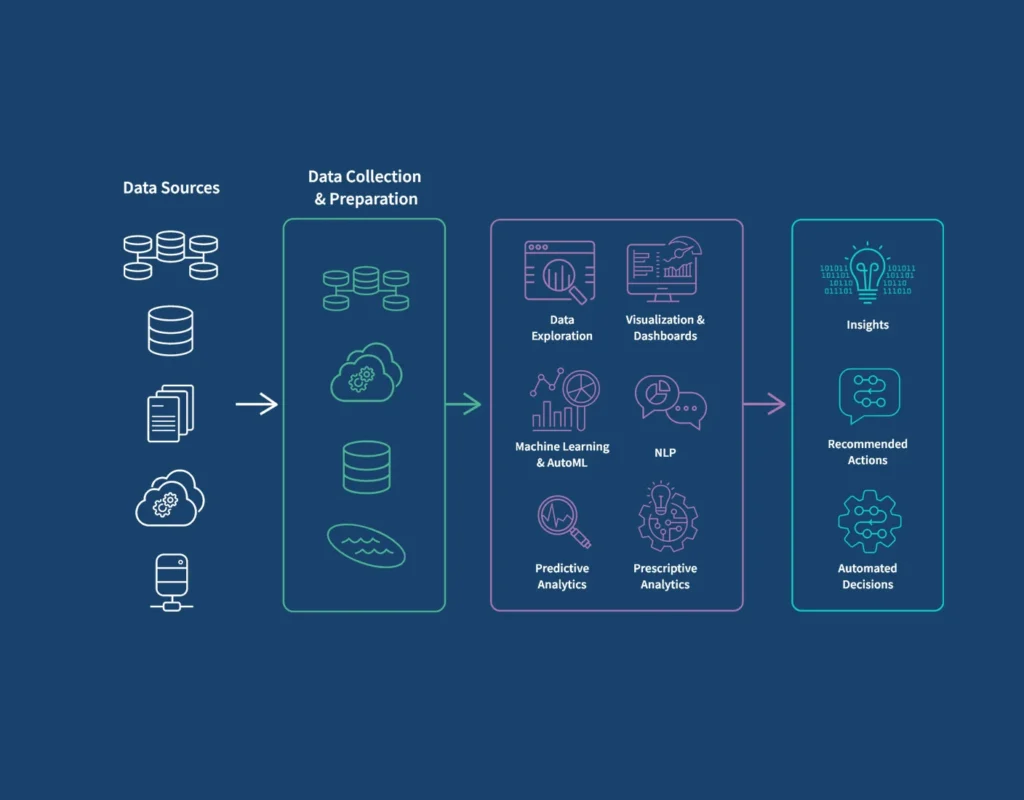Let’s be honest—data is everywhere these days. Your business probably collects it by the truckload: website clicks, app usage, sales numbers, customer feedback, social media interactions… you name it. But here’s the deal: all that data is basically useless if you can’t make sense of it. That’s where AI-powered analytics comes in. These tools don’t just stare at numbers—they turn them into insights that actually help you make decisions.
So, what does that mean in practice? Imagine you’re running an online store. You notice your cart abandonment rate is high, but why? A traditional spreadsheet won’t tell you much. An AI analytics tool, on the other hand, can spot patterns in customer behavior, predict why people leave their carts, and even suggest what changes might reduce that number. It’s like having a detective for your business—but faster, smarter, and way less dramatic.
The Magic Behind AI Analytics
Okay, here’s something to think about. AI-powered analytics isn’t magic—it’s math, algorithms, and a bit of pattern recognition. These tools use machine learning models to examine massive amounts of data, identify trends, and sometimes even forecast future outcomes.
Take predictive analytics. Instead of just looking at what happened last month, predictive models can tell you what might happen next month based on trends. It’s like having a weather forecast for your business. Sure, it’s not 100% accurate, but it gives you a big-picture view that’s way more useful than guessing.
Then there’s natural language processing (NLP). This lets AI sift through customer reviews, social media mentions, or survey responses and understand the sentiment behind them. Ever read a hundred customer reviews and felt like you needed another week just to process them? AI can do that in minutes, and it even tells you whether people are generally happy, frustrated, or somewhere in between.

Tools That Actually Make a Difference
Not all AI analytics tools are created equal. Here are a few that stand out and why they’re worth checking out:
- Tableau with AI Extensions – Tableau has been around forever for data visualization, but their AI-powered features now let you forecast trends and even ask questions in plain English. Want to know which product will sell best next quarter? Just type it in.f
- Power BI with Azure AI – Microsoft’s Power BI isn’t just for dashboards anymore. With Azure AI integration, it can predict churn, suggest upsell opportunities, and detect anomalies you might’ve missed.
- Google Analytics 4 (GA4) – GA4 has leaned heavily into AI for predictive metrics. It can tell you which users are most likely to convert, where your traffic is going, and even highlight emerging trends automatically.
- Zoho Analytics with AI – Zoho’s platform uses AI to automatically generate insights and explanations, so you don’t have to be a data scientist to understand what’s happening. Sometimes it feels like having a friendly data consultant on call 24/7.
Why You Should Care
Here’s the thing: data is only as good as the action you take from it. If you’re not using AI to interpret your data, you’re leaving opportunities on the table. You might spot a declining trend in sales—but without AI, you’re left guessing why it’s happening and what to do about it. With AI-powered analytics, you can spot the exact products or user segments causing the drop and fix the problem before it hurts your bottom line.
Plus, let’s face it—AI analytics tools save a ton of time. Instead of spending hours digging through spreadsheets, you can get insights in minutes. That means more time for strategy, experimentation, and actually growing your business.
Getting Started Without Overwhelm
I get it. The idea of AI analytics can feel intimidating. But you don’t need to overhaul everything at once. Start small. Pick one tool that integrates easily with your current workflow and focus on one business problem. Maybe it’s customer churn, maybe it’s website engagement. Learn how the tool surfaces insights, experiment, and then expand from there.
And don’t worry if it feels like a learning curve. Even seasoned marketers and analysts admit it takes time to get comfortable with AI-powered analytics. The important part is just to start—let the tool show you what’s possible, one insight at a time.
Final Thoughts
AI-powered analytics is more than a buzzword. It’s a way to take the chaos of data and turn it into something actionable. Whether you’re a small business owner, a marketer, or part of a large enterprise team, these tools can give you clarity, speed, and a competitive edge.
Here’s something to chew on: ignoring AI analytics is like driving blindfolded on a busy highway. Sure, you might get where you want to go… but why take that risk when you can have a GPS that not only guides you but predicts traffic jams before they happen?
Start exploring, experiment, and let the insights guide you. Your future self (and your business) will thank you.

